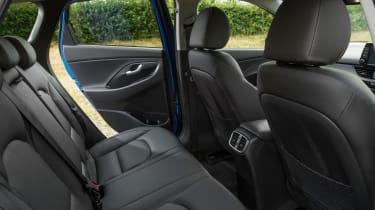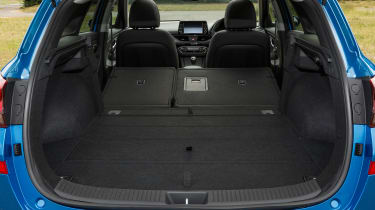Hyundai i30 Tourer estate - Practicality & boot space
Strong marks here: the Hyundai i30 Tourer is a very practical car
To prevent ennui setting in, the designers behind the Hyundai i30 Tourer have given it a swept-back roofline, a small rear spoiler and a tapered rear end – although none of these elements has much of a practicality cost, as the i30 Tourer is impressively spacious.
Hyundai i30 Tourer interior space & storage
While the i30 hatchback has slightly limited rear headroom, this is far less of a problem in the Tourer estate, as that swept-back roof doesn’t start to taper until it gets to the luggage compartment; adults should be able to get comfortable in the rear without issue.
The doorbins and glovebox are of a decent size, although note you don’t get an armrest between the front seats (or in the rear) with S trim, while you have to go for high-spec Premium of Premium SE if you want the front central armrest to offer sliding adjustment.
Boot space
At 602 litres, the i30 Tourer doesn’t have quite the largest boot in this class. Given, however, that it trails the Volkswagen Golf Estate by just three litres and the Skoda Octavia Estate by just seven, we reckon most owners will overlook this deficit – assuming they notice it at all.
The Tourer’s boot is also a good, square shape, and expands to an impressive 1,650 litres when both the split-folding rear seats are dropped. This is slightly more space (30 litres) than the Golf Estate offers when its seats are dropped, and it overshadows the Ford Focus Estate by 122 litres and the Astra Sports Tourer by 62 litres. It’s a shame Hyundai won’t offer luggage rails for the boot floor to UK customers, though.
Towing
Which engine you choose will affect the i30 Tourer’s towing capacity. The 1.0-litre petrol is limited hauling a 1,200kg braked trailer, while the 1.4-litre petrol can tow 1,400kg and the diesels can manage 1,500kg.
Which Is Best?
Cheapest
- Name1.5T GDi 48v Hybrid Advance 5dr
- Gearbox typeManual
- RRP£25,275
Most Economical
- Name1.5T GDi 48v Hybrid Advance 5dr DCT
- Gearbox typeSemi-auto
- RRP£26,475
Fastest
- Name1.5T GDi 48v Hybrid Advance 5dr
- Gearbox typeManual
- RRP£25,275















